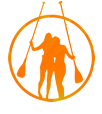
The trip presented many hazards:
- The North Coast of the island is hostile with rocks and many steep cliffs – there are very few places to land or shelter. This meant that we had some long passages to complete. 27km on day 2 was not optional!
- The North East tip of the island is exposed and often has rough seas – we had to wait for the right weather window to round Formentor.
- There are large area’s of the island where there is no phone signal – a big problem in case of emergency. We took VHF radio to make contact via shipping channels.
- Some parts of the island have no road access, everyday the we needed to replenish water supplies from support teams and boats.
- Wind – conditions above 25kph (15mph) are deemed unsafe. We had strong winds that started at 12 noon most days meaning we had to start early to get our hours of paddling in.
- Swell & ocean waves – often when there is no wind at all these caused problems for balance and direction. Both are weather and pressure dependent. This also presented problems launching and exiting the water.
- Tides and Currents – though the seas are not hugely tidal, currents had significant impact – (see map above).
- Shipping lanes – particularly around Alcudia and Palma. Paddle boards are not visible to large ships and ferries, we needed boat support for both and didnt manage to have any for Alcudia bay leading to a very frightening experience with a Car Ferry.
- Ghost nets, floating wood, buoys, plastics and other obstacles post threat to floatation. Sadly the number of these is high from human pollution in our oceans.
- Dolphins, Ocean Sun Fish and Manta Ray all spotted – none hit the boards and made us topple luckily.
- Sharks – Great White shark spotted 10 days after we finished off the south coast of Mallorca.
- Holiday makers on jet skis and sailing boats unfamiliar with our venture, it was high season for tourism and the coast was busy making many waves which are tough to balance in.
Personal awareness and care
- The biggest challenge was drinking water. We needed to drink at least 5L a day each with an additional 2L needed for camping. This is heavy to carry and difficult to replenish. The route has to be planned carefully in order to be able to pick supplies from support vehicles by roads/ boats.
- Jelly Fish – There were many jelly fish in the water. In waves the water often comes over the sides or front of the board onto feet – possibly bringing with it jellies – this was a real fear. We carried ointment, vinegar, antihistamine tablets and and an epi-pen – we checked the water carefully and moved jelly fish aside when entering to launch.
- Storms – unseasonable weather hit us for June including rain, lightening and strong winds.
- Overheating – When the sun did shine it was HOT, we tried to avoid the hottest parts of the day by paddling between 5am and 10am and then again perhaps in the late afternoon/ evening. We were protected by wearing white rash-vests, and white hats with full brim as well as factor 50 suncream.
- Mosquitos – a real issue at night, we had head nets and insect repellent to combat.
- Getting wet (rain and sea spray) – drybags from Aquapac protected all items on the board.
- Blisters on hands from the paddle – Paddling every day for the best part of a month was uncomfortable – we built up our calluses and took gloves & zinc tape for protection.
- Luggage volume – created a problem for balance and windage steering the board.
- Weight – we carried 15-20kg per board – which is effectively carrying a mid-sized suitcase all the time.
- Stamina – paddling burns a lot of calories. We had to eat regularly for physiological balance. In addition everyday we took recovery drinks and freeze-dried expedition meals.
